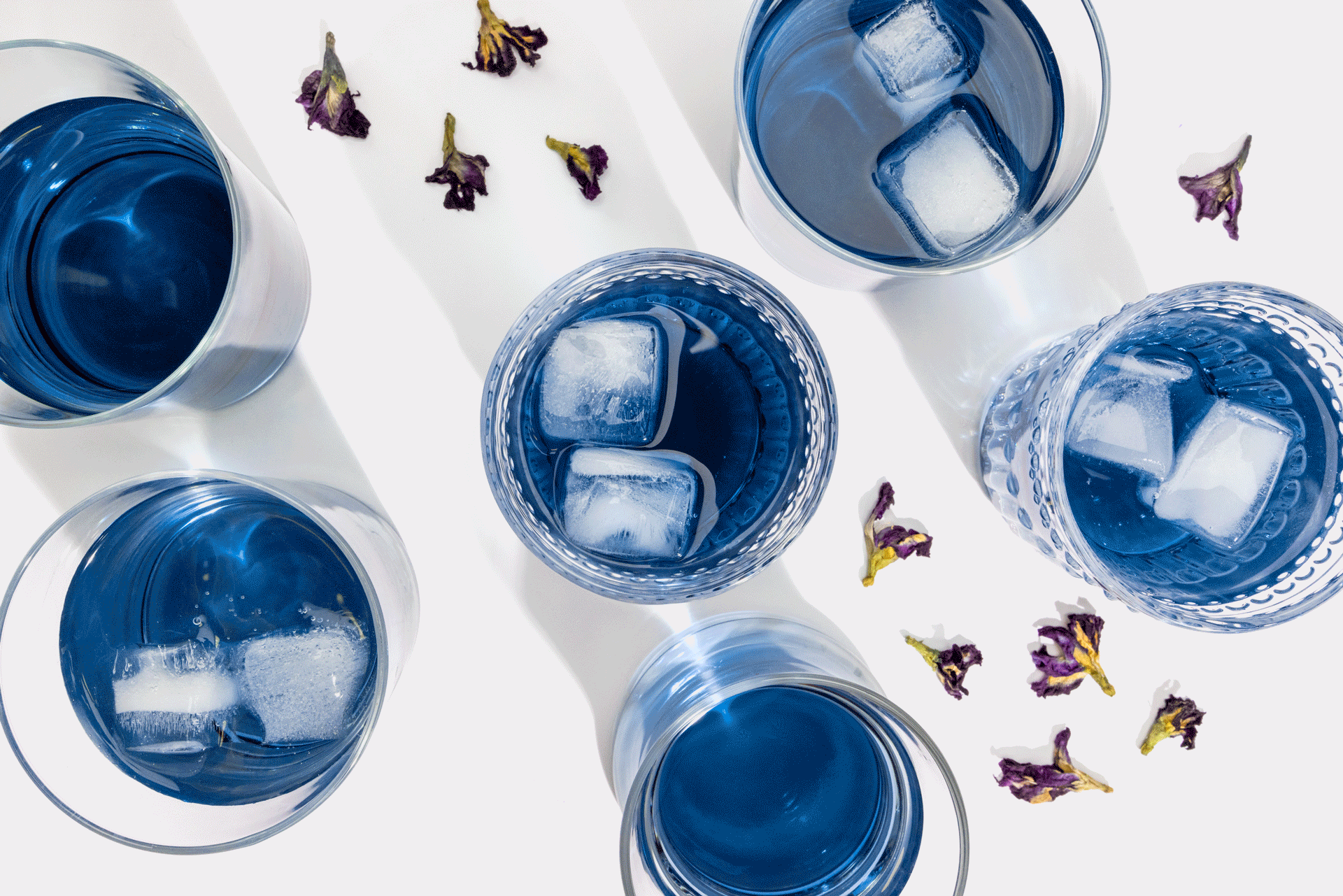Ingredients on the Rise: Butterfly Pea Flower
(This article covering butterfly pea flower is part of a series we’re calling Ingredients on the Rise, where we’re tracking emerging consumer interest in healthy and functional food, beverage, and supplement ingredients through a mix of social listening and online research. Read further for insights on the commonly understood benefits and use of the pea flower, its formulation considerations, and the broader cultural lens that marks its rising popularity.)
Harnessing the Power of Color
Consumers want foods and beverages that meet not only their health goals and altruistic requirements, but also lean into the specific aesthetic of their current self-expression. As such, color is a key driver in CPG sales. The active vibrancy of sports drinks, the holistic energy of teas and kombuchas, and the fun and whimsy of children’s cereal, sauces, dairy, and drinks all of these are supported by lively colors. The all-natural blues, purples, and pinks achievable with butterfly pea flowers are ideal for conveying many brand identities. Successful brands will deeply understand the myriad of specific cultural archetypes and leverage the vibe to meet those customer needs and desires.
Butterfly Pea Flower Composition and Origin
C. ternatea commonly known as blue pea, or butterfly pea, is a beautiful evergreen vining legume that produces bright purple blooms. Native to equatorial Asia, it has been naturalized as a pan-tropical plant on all six agriculturally viable continents and is even cultivated in some more temperate regions. It is growing in popularity as a crop due to new discoveries related to its anti-microbial and insecticidal attributes. It is also a nitrogen fixing crop that improves poor soil for agriculture, serves as a good feed crop, suffers from few diseases, and has low water needs.
Butterfly pea flowers have a floral, and mildly sweet flavor often described as a taste similar to chamomile. Because of its subtle flavor, it’s an ideal pairing in a variety of flavor formulations, and the vibrant color of the blossom comes from antioxidant plant phenols called anthocyanins that offer a variety of health benefits.
Butterfly Pea Flower Benefits
These phytonutrients work as direct antioxidants as well as showing anti-inflammatory properties, offering cognitive support, and moderating blood sugar. Further, this amazing ingredient is a fantastic addition to skincare products with clinical studies showing butterfly pea flower extract increases the hydration of skin by up to 70%, positively affects intercellular collagen, reduces topical inflammation and irritation, and protects against the photoaging effects of the sun.
As scientific documentation accumulates on these elements of the flower, we will no doubt see many more cosmetics and supplements taking advantage of the power of nature.
CPG Companies Meet Consumer Desires with Pea Flower
Current consumer inclination is showing a hard turn away from artificial colors and preservatives with nearly 40% of consumers avoiding artificial colors in their food and beverage purchases, and more than 30% avoiding artificial colors in their health and beauty products.
Simultaneously, consumers continue to “eat with their eyes” with fads and trends craving vibrant and bold colors, fantasy flavors, and a touch of the exotic. In the face of this powerful, and paradoxical shift CPG brands must find ways to adapt their product offerings to remain competitive. The exotic butterfly pea flower offers CPG companies and manufacturers a great opportunity to do just that.
Formulation Insight
Because the color expression is dependent on the acidity of the formulation matrix and the way the end product is used, there is an opportunity for Instagram-worthy color change products like blue gin that turns purple or pink depending on the mixer in your cocktail, unicorn sunrise smoothies that reflect a beautiful color gradient in the glass, or a 2-part RTM drink powder that will draw all eyes at your next group fitness class.
Formulation Opportunities
While the various wellness uses of this ingredient will appeal to health and beauty consumers and brands, possibly its greatest value is derived from the powerful pigments in the blossoms. Extracts from this flower range in color from a pure sea blue to a glowing magenta hue depending on the pH of the formulation it’s used in.
Colors that evoke the vibrancy and freedom of youth in the summertime, the vast self-confidence of mermaids and sirens in their element, the timelessness of classic architecture and elite academia, the deep wisdom of a fairy witch in the woods (all aesthetics have been burgeoning for the last several years and are exploding anew in the 2023-2024 cultural paradigm).
Applicable Cultural Trends
Consumers are drawn to viral marketing and brand messaging that is Insta-worthy. CPG brands should harness this to assist in pushing functional ingredients, clean labeling, and free-from claims even further. The draw of sustainable agriculture practices like low water footprint and regenerative farming can also boost expansion into the health and wellness industry.
Working with MarketPlace
Founded in 2002, MarketPlace is a strategic partner to health and wellness, pet and animal, and food and beverage brands. Through business strategy, industry focus, and marketing expertise, we help our partners grow.
If you have any questions or would like to request more information about our study, please contact us at hello@marketplacebranding.com. If you’re working to launch a supplement or food brand or to expand your brand offerings and distribution, we do that too—let’s talk!
